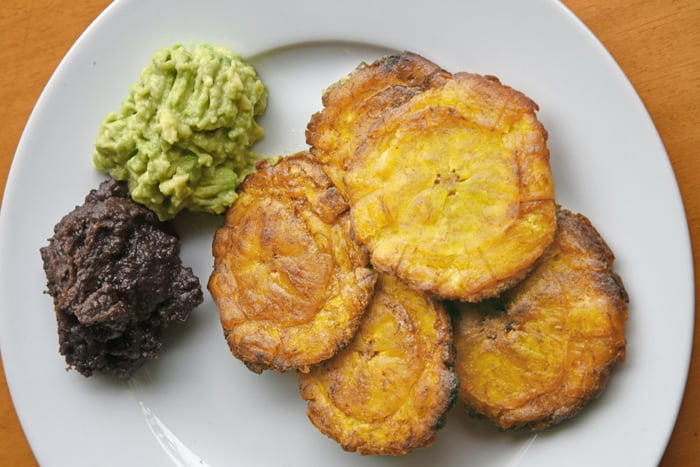Take a hard green plantain (plátano), cut it crosswise into rounds, fry them in oil, mash them flat, and fry them in oil again. If this doesn’t sound all that appetizing, you may not realize this is how you make patacones, a common and scrumptious treat in Costa Rica.
As simple as they are, there are things many people don’t know about this ubiquitous dish. There is more to patacones than meets the eye and so here are 5 interesting facts about Patacones (Fried Green Plantains) that you may not know.
1. The Origin of the Name Patacon
The name patacón comes from various Colonial Era Spanish and Portuguese silver coins. In an ironic double-back, tostón, a name applied to patacones in some other countries, has been used as slang for a Mexican fifty-cent piece.
2. Where Plantains Come From
Plantains belong to the banana family. At first, many people from northern climes mistake them for large bananas. They are native to India and are popular today in the tropical areas of Africa, the Caribbean, and Latin America. They have been grown in subtropical Florida, but they do not play well with frost.
3. How Patacones are made in Costa Rica
In Costa Rica, patacones are usually pressed into disks several inches across and served with ground beans or chimichurri (the tomato, onion, and cilantro mix). They are also commonly served as accompaniments to other dishes. Warm, chewy patacones are a wonderful counterpoint to the cool fresh citrus taste of ceviche. They are almost always cooked to order, so you may have to wait a little longer for your ceviche—well worth it.
In other countries, and even from one Costa Rican region to another, shapes and toppings for patacones will vary. They might be larger, either round or oblong or even shaped into baskets, and topped with all manner of beans, meat, cheese, fish, vegetables and salsas. Depending on the country, they are also known as tostones or fritos. A patacón heaped high with other delights is a hearty meal in itself.
4. A Famous Song about Patacones
If you start a conversation about patacones, somebody will inevitably bring up “Patacón Pisao,” a popular Dominican song about a guy who insists his wife make him patacones. Pisao is a vernacular version of the word pisado, stepped on — smashed, flattened. In fact, all patacones are “stepped on.”
“Patacón Pisao” is just a song title; it does not refer to any specific dish. It may be used by a particular restaurant as their name for a patacón arreglado, a patacón with any combination of delicious things piled on top.
5. Buying Plantains in Costa Rica
When shopping for plantains, you may well run across two fused together. This is called a guápil. Actually, any plant product with two units combined in this manner is called a guápil. Finding a guápil is considered good luck, but conjoined plantains are so common as to dilute the good fortune; coffee beans or other less frequent guápiles are stronger mojo.
Also, a double plantain is sold as a singleton, for the single unit price. This is likely because they are not considered suitable for making patacones, due to the lack of roundness or uniformity.
Final Thoughts
If patacones are not part of your Costa Rican diet, you are missing out on another great dish that gives the lie to the myth that Tico food is only rice and beans. If you are fortunate enough to find a restaurant that piles them high with goodies, you have an exciting new alternative for a dinner out. If not, don’t neglect this underappreciated delight as a side dish or a snack.
First published in 2016






